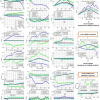Free Online Productivity Tools
i2Speak
i2Symbol
i2OCR
iTex2Img
iWeb2Print
iWeb2Shot
i2Type
iPdf2Split
iPdf2Merge
i2Bopomofo
i2Arabic
i2Style
i2Image
i2PDF
iLatex2Rtf
Sci2ools
ICIP
2008
IEEE
2008
IEEE
EKF pose estimation: How many filters and cameras to use?
The Extended Kalman Filter (EKF) is suitable for real-time pose estimation due its low computational demand and ability to handle the nonlinear perspective camera model. There are many EKF based approaches in the literature; some are very recent while others exist for about two decades. These methods differ in two main aspects: the number and arrangement of cameras, and the number and usage of filters. In this work, we will compare these approaches using simulations and real experiments. As far as we know, it is the first attempt to do this with such details. We will show which is suitable under different motion patterns, and explain the effect of the bas-relief ambiguity upon the accuracy of the different approaches. Additionally, we will discuss how to solve the scale factor ambiguity, and suggest the best strategy to deal with the features fed to the filter.
Bas-Relief Ambiguity | EKF Based Approaches | Extended Kalman Filter | ICIP 2008 | Image Processing | Real-time Pose Estimation | Scale Factor Ambiguity |
| Added | 20 Oct 2009 |
| Updated | 27 Oct 2009 |
| Type | Conference |
| Year | 2008 |
| Where | ICIP |
| Authors | Mohammad Ehab Ragab, Kin-hong Wong, Jun Zhou Chen, Michael Ming-Yuen Chang |
Comments (0)

